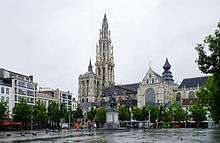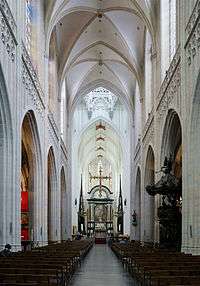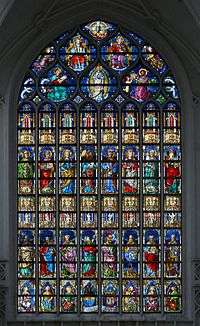Cathedral of Our Lady (Antwerp)
| Cathedral of Our Lady | |
|---|---|
 Cathedral of Our Lady | |
| Basic information | |
| Location | Antwerp |
| Geographic coordinates | 51°13′14″N 4°24′02″E / 51.22056°N 4.40056°ECoordinates: 51°13′14″N 4°24′02″E / 51.22056°N 4.40056°E |
| Affiliation | Catholic |
| Rite | Roman |
| Region | Diocese of Antwerp |
| Year consecrated | 1521 |
| Ecclesiastical or organizational status | Cathedral |
| Leadership | Johan Bonny |
| Website | De Kathedraal |
| Architectural description | |
| Architect(s) | Jan and Pieter Appelmans |
| Architectural type | Cathedral |
| Architectural style | Gothic |
| Groundbreaking | 1352[1] |
| Completed | 1521 |
| Specifications | |
| Direction of façade | W |
| Capacity | 25,000 |
| Length | 120 metres (390 ft) |
| Width | 75 metres (246 ft) |
| Width (nave) | 53.5 metres (176 ft) |
| Height (max) | 123 metres (404 ft) |
| UNESCO World Heritage site | |
| Part of | Belfries of Belgium and France |
| Criteria | Cultural: ii, iv |
| Reference | 943-002 |
| Inscription | 1999 (23rd Session) |
The Cathedral of Our Lady (Dutch: Onze-Lieve-Vrouwekathedraal) is a Roman Catholic cathedral in Antwerp, Belgium. Today's see of the Diocese of Antwerp started in 1352 and, although the first stage of construction was ended in 1521, has never been 'completed'. In Gothic style, its architects were Jan and Pieter Appelmans. It contains a number of significant works by the Baroque painter Peter Paul Rubens, as well as paintings by artists such as Otto van Veen, Jacob de Backer and Marten de Vos.
The belfry of the cathedral is included in the Belfries of Belgium and France entry in the list of UNESCO World Heritage Sites.
History
_1800.jpg)


Where the cathedral now stands, there was a small chapel of Our Lady from the 9th to the 12th century, which acquired the status of parish church in 1124.[1] During the course of the twelfth century, it was replaced by a larger Romanesque church (80 metres (260 ft) long and 42 metres (138 ft) wide).[1]
In 1352, construction was begun on a new Our Lady’s church which would become the largest Gothic church in Belgium. In the beginning, it was to be provided with two towers of equal height. In 1521, after nearly 170 years, the new church of Our Lady was ready. The south tower reached only as far as the third string course.
During the night of 5–6 October 1533, the new church was largely gutted by fire, however Lancelot II of Ursel managed to save the building. The completion of the second tower was therefore delayed, which led to its ultimate postponement. Moreover, the church only became cathedral of the bishopric of Antwerp in 1559 but lost this title again from 1801 to 1961, following the Concordat of 1801.[1][2] During the Iconoclasm of 20 August 1566 (part of the Beeldenstorm at the start of the Eighty Years' War), Protestants destroyed a large part of the cathedral interior. Later, when Antwerp came under Protestant administration in 1581, a number of artistic treasures were once again destroyed, removed or sold. The restoration of Roman Catholic authority came in 1585 with the fall of Antwerp.
In 1794 the French revolutionaries who conquered the region plundered Our Lady’s Cathedral and inflicted serious damage.[1] Around 1798, the French administration intended to demolish the building but after each blow, the cathedral was able to recover. In 1816, various important works of art were returned from Paris, including three Rubens masterpieces. Over the course of the 19th century, the church was completely restored and refurnished.
Between 1965 and 1993, a complete restoration took place.[1]
Musical life
At the beginning of the 15th century, the cathedral's choir started developing an active musical life, and as a result, the cathedral's importance in the history of music soon soared. Johannes Ockeghem, one of the most important composers of the 15th century, served here as a vicar-singer in 1443, and so did Jacob Obrecht between 1492 and 1497. Organists who worked at the cathedral include Henry Bredemers (1493–1501), who went on to become a teacher to Philip the Handsome's children, and the renowned English composer John Bull (1615–1628), who fled to Flanders from his home country escaping justice. From 1725 to 1731 Willem de Fesch served as Kapelmeester followed from 1731 to 1737 by Joseph-Hector Fiocco. Lesser known, but locally important figures, such as Jacobus Barbireau and Andreas Pevernage, also worked at the cathedral.
Significant architectural details
The church's one finished spire is 123 metres (404 ft) high,[3] the highest church tower in the Benelux. Charles V, Holy Roman Emperor commented that the spire should be kept under glass, and Napoleon compared the spire to Mechlin lace.[4] The largest bell in the tower requires 16 bell ringers.[5]
The west portal features statues which include the missionary Saint Willibrord. He is thought to have spent time in Antwerp in the 7th century.
Major works of art
The cathedral possesses some major works of art :
- The Raising of the Cross – Peter Paul Rubens
- Assumption of the Virgin Mary – Peter Paul Rubens
- The Descent from the Cross – Peter Paul Rubens
Two of these artworks were confiscated by Napoleon and moved to France, The Raising of the Cross (which was actually the main altar piece of the St Walburga church) and The Descent from the Cross, but were returned to the cathedral in the 19th century.[4]
Burials
Inside the Catedral some important graves still can be found, amongst them family members of the noble houses of Rubens, Fourment, Goubau, Tucher, Plantin, Moretus, de Borrekens, etc. Some stones were places after the Saint-Michaels abbey's church was lost.[6]
- Bishops
- Laevinus Torrentius
- Ambrosius Capello
- Aubertus van den Eede
- Municipal and Grand Almoners of the City
- Aegidius de Brialmont. (+1668) marries to Barbe van Wyck.
- Petrus de Vos, (+1719) married to Maria Clara Bosschaert.
- Alexander I Goubau, (1540-1614), married to Anna Anthoni.
- Joannes Beerenbroek, (+1761)[6]:173
- Hendrik Moens, (+1643): Alderman of Antwerp: married to Maria Fourment, sister of Hélène Fourment.
- Joannes Placquet, (+1652); married to Anne Vermeulen.
- Adriaen Stevens, (+1640) married to Maria Bosschaert.[6]:137
- Godefridus Joseph van Paeffenrode, (+1763) Alderman of Antwerp.
- Embertus Tholinckx.[6]:141
- Ludovic van den Heuvel, (+1727) knight and Lord of Calfennes. [6]:141
- Joannes van Colen, (+1724) Lord of Burcht.[6]:41
- Artists
- Michiel [de] Vri[e]ndt, (+1637), married to Sara Rabat: Panel-maker of P.P. Rubens.[6]:136
- Joannes Cnobbaert, (+1637), Son of Michaël; married to Marie de Man; Editor and Publisher.[6]:132
- Simon Jordaens, married to Maria de Bodt.
- Daniël Faes, (+ 1654) , book-Editor; married to Sara de Waele.
- Abraham Ortelius, (+1598) placed after burials inside Saint-Michaels Abbey. [6]:129
- Cornelis de Vos, marr. Susanne Cock, children Joannes Bptiste and Elisabeth
- Philippus Gallaeus, (+1612), Sculptor, married to Catharina Rollanda.[6]:130
- Peter Verbrugghen, sculptor. Marr. Cornelia Quellinus
- Jan Wildens, (+1653) marr. Maria Stappaert, niece of Hélène Fourment.
- Nicolaes Somers, marries to Anne de Winter. Dean of the Silver sculptors.
- Henricus de Moy, marr. Clara van Gulick,[7] parents in law of Philip I Rubens.
- Joannes Brantius: iuris conslvltius, married Clara de Moy; parents of Isabella Brant.[6]:176
- Hubert Waelrant
- Politicians
- Michaëllis Cnobbaert, (+1623) Alderman, married to Jacominne de Roy.[6]:132
- Alexander vander Goes (+1642), Alderman, married Maria della Faille.[6]:176
- Maol Muire Ó hÚigínn, Archbishop of Tuam in Ireland (1586–1590) – died in Antwerp on his return to Ireland from Rome
- Maria Goubau, marr. Renald Huygens.
- Thomas de Prêt, (+1653) married to Suzanne Fourmenois.
- Gaspar Gevartius, Secretary of the City.
- Jacobis Anthonius de Witte (+1631); royal Councillor and Judge, married to Maria Catharina Mailliart.
- Jacobus della Faille.
- Abraham Verspreet (+1638), married to Elisabeth van der Noot; Greffe of the political Council.
- Henricus Walraevens.
- Reynier Floris.
- Bartholomeus Tucher, (+1542); married to Herberta Dens.[6]:128
- Plantyn family
- Joannes Moretus, marr. Maria Plantyn.
- Balthasar Moretus, marr. Anne Goos.
- Christopher Plantyn, marr. Joanne Riviera.
- Arnold de Pret, marr. Maria Moretus.
Facts and figures
|
|
gallery
Notes
- 1 2 3 4 5 6 7 8 9 10 11 12 13 14 15 16 17 18 19 20 21 "History". Diocese of Antwerpen. Retrieved 2009-01-03.
- ↑ The bishopric of Antwerp was abolished during this period
- ↑ "Cathedral of Our Lady". www.visitantwerpen.be. Retrieved 2016-02-10.
- 1 2 Coe, Fanny E. (1896). Dunton, Larkin, ed. The World and Its People. Volume 9. Book V. Modern Europe. Boston: Silver, Burdett & Co. p. 164.
- ↑ Coe, Fanny E. (1896). Dunton, Larkin, ed. The World and Its People. Volume 9. Book V. Modern Europe. Boston: Silver, Burdett & Co. p. 165.
- 1 2 3 4 5 6 7 8 9 10 11 12 13 14 De Onze-Lieve-Vrouwekathedraal van Antwerpen. Kunstpatrimonium van het Ancien Régime. Brepols. 1996. ISBN 9789056220075.
- ↑ Antwerpen - Cathedrale Kerk, Volume 1
References
- Rynck, Patrick (2005). The Cathedral of Our Lady in Antwerp. Ghent: Ludion. ISBN 90-5544-580-0.
External links
| Wikimedia Commons has media related to Onze-Lieve-Vrouwekathedraal (Antwerp). |

















